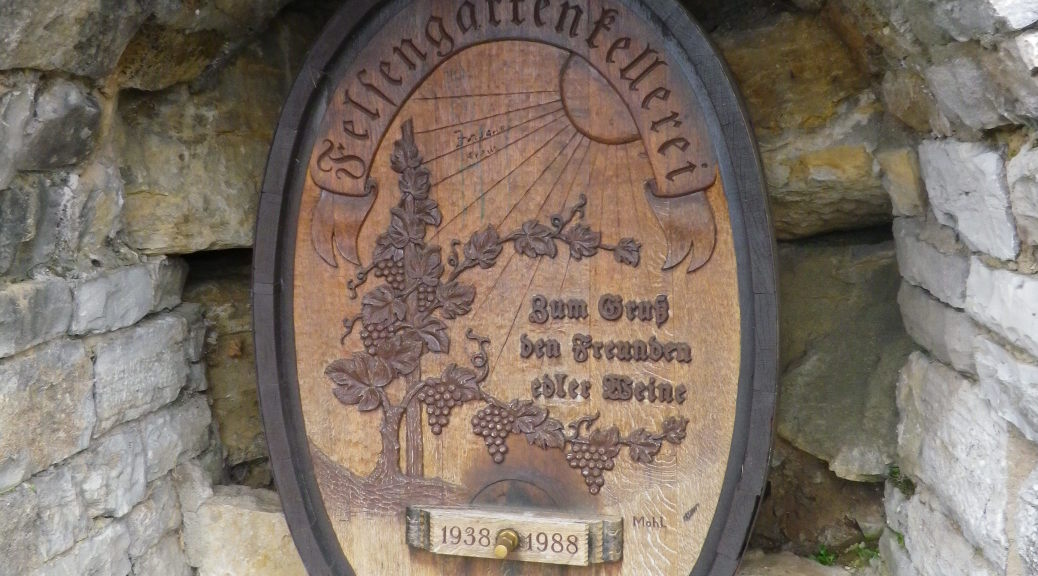What I Learned:
About 20 miles north of Stuttgart, Germany, there is a distinctive grape growing area, lining the Neckar River as it flows north past the towns of Mundelsheim, Hessigheim and Besigheim. An unusual geological feature here is a fractured, limestone cliff with rock outcroppings that tower above the Neckar. Known as the Felsengarten, this site is favored by local rock climbers, as well as wine lovers who delight in visiting the vineyards surrounding the cliff, and the local wine cooperative, the Felsengartenkellerei, at the base of the cliff.
Steep vineyards line the Neckar in the area from Mundelsheim to Besigheim. Several sharply turning loops of the river here create bowls and south-facing vineyards which effectively capture the sunlight and warmth thus allow grapes to ripen well.
As in much of the Wuerttembergisch Unterland, both red and white grapes are grown for wine production, reds predominating. The most common varietals, in order of predominance are: Trollinger, 24%; Schwarzriesling, 17%; Lemberger, 16%; Riesling, 14%; Spaetburgunder, 9%; Kerner, 4%; Samtrot, 2%. The remaining 30% is made up of a wide variety of different grapes, to include Dornfelder, Weissburgunder, Grauburgunder, and Acolon.
The Acolon varietal is a relatively new red-grape varietal developed by crossing Dornfelder with Blauer Lemberger. Comparatively speaking, it is widely planted in Wuerttemberg. Acolon wine, a dry, medium-bodied, fairly tannic red, is therefore relatively easy to find in this area, but not so easily found even in other areas of Germany.
A red wine blend known as Trollinger mit Lemberger is also found throughout much of the Wuerttemberg area. This cuvee rounds out flavors of the Trollinger and Lemberger varietals, to produce a slightly more nuanced wine. It is interesting to visit a wine estate to compare this wine with one wine each from the same vintage.
According to information from Stadt Besigheim, there are 17 named vineyards in and around the Besigheim area, either on or overlooking the Enz and/or the Neckar Rivers.
The local Felsengartenkellerei, capitalizes on the abundance and variety of vineyards in this area. This popular winery’s products can be seen in many German supermarkets within the state of Baden-Wuerttemberg. (It is akin to finding Turning Leaf wines in most Californian wine stores.)
What I Tasted:
2013 Trollinger, Felsengartenkellerei, Qualitaetswein: an off-dry red wine with cherry candy notes – unbelievably sweet on my tongue, mild oak tones, but also a slightly spicy aftertaste. Light to medium mouthfeel, silky on the tongue, more acidic in the throat.
2013 Lemberger, Felsengartenkellerei, Qualitaetswein: a dry red wine with dark red, almost purple color; mild yeast scent, mild flavor of cherry, medium acidity and medium body.
2013 Trollinger mit Lemberger, Felsengartenkellerei, Qualitaetswein: a dry red wine with spicy and fruity notes, rather acidic, medium body.
2013 Spaetburgunder, Felsengartenkellerei, Qualitaetswein: a dry red wine with medium red color; with slightly oaky and smoky flavors, and a hint of floral notes, and a bit of spice.
2013 Acolon, Felsengartenkellerei, Qualitaetswein: a dry red wine with very dark red color; blackberry and slight yeast notes; low acidity with very slight tannins.
2013 Samtrot, Felsengartenkellerei, Qualitaetswein; a medium dry wine with very light ruby color; sweet berries – wild strawberry, cherry – flavors predominate; a slight fizz on the tongue; overall a clean, light, slightly sweet fruity wine.
2011 Trollinger, Mundelsheimer Schalkstein, Qba, Wuerttembergische Weingaertner Zentraler Genossenschaft (WZG): a dry red wine with light ruby color; fruity on the nose, with spicy, peppery, notes, and hints of green fruits; Low acidity and low tannins, and overall, a clean, light, and fruity red reminiscent of roses.
2011 Lemberger, Mundelsheimer, Qualitaetswein, Lauffener Weingaertner: a dry red wine with dark red almost purple color; scent of tobacco, cherry and tobacco flavors, slight smoke; medium-low acidity and medium body.
